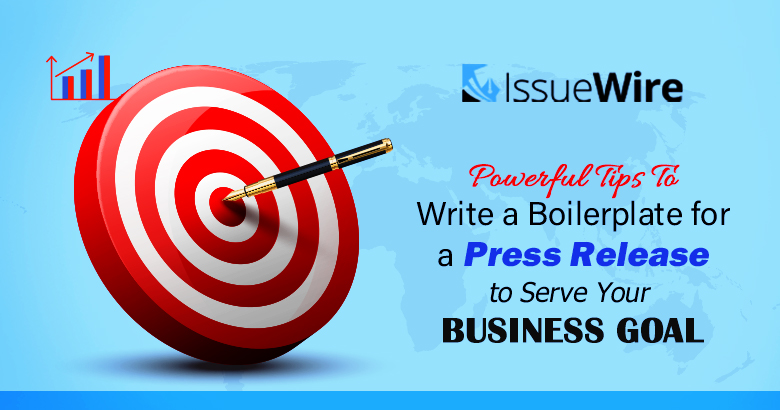You probably have got all the necessary updates about how powerful and effective a press release is. And, why not, it is indeed a very smart marketing approach. But you can only make a great dish when you put in the right amount of spices or ingredients. And the same goes for a Press Release as well.
An effective PR constitutes a lot of things and one of them is a Boilerplate. It’s a small but very vital part of a PR. So far, you must have ignored this small segment. But, if you want to know how to write the perfect PR, you must know how to write a boilerplate for a press release.
Let’s start with the basics.
What is a Boilerplate?
For years, a boilerplate has been used to cap a press release, which means that it defined the ‘About’ part of the company, artist, author, or any other. Your PR could be great but unless the boilerplate is creatively projected, expect faint results. Get your readers blown away with the last part, the boilerplate!
In short, a boilerplate can determine the success of a PR. People not only care about the news but also focus on who is making the news. So, it’s important to project your leadership qualities appealingly.
What is the objective of a Boilerplate?
Have you ever heard the journalists or the big media houses hovering with one PR the whole day? You haven’t, right? It is because that never happens. Journalists spend less than a minute reading a PR. Put yourself in their shoes and understand how you can make it easier for them to notice you.
This is where the boilerplate helps! The boilerplate adds much more clarity to the PR since it shares your company’s description.
- What does a Boilerplate typically include?
- Even though there aren’t any hard and fast rules, it often includes the following:
- Biographical information about the quoted person or the CEO/ Founder
- History about the company
- Additional data (demographic details, sales figures)
- Links to articles or other reports that are important to the journalists
- CTA
- The vision of the Company
So you know how it makes the journalists’ job easier. But that’s just one part of the spectrum.
Other remarkable benefits of a Boilerplate are:
1. SEO
The boilerplate is usually repeated on all your PRs which get subsequently published by other sites as well. Adding your target keywords in that portion ensures that your brand gets associated with the stated keywords.
Next, Google will start associating your brand with those keywords. This would give you added SEO advantages.
2. Save Time
Having a punch boilerplate saves you tons of time when you’re drafting a new PR.
3. CTAs
You probably know how impactful the CTAS is. You can add targeted CTAs in the boilerplate and direct the traffic to a specific page.
4. Improved Search-ability
Journalists who research your brand can search for the boilerplate text and get access to all the press releases from your business. Moreover, adding suitable keywords to the press release ensure that the journalists can find the PR when searching across a whole PR database.
Where is the Boilerplate placed in the Press Release?
Well, this is easy. The boilerplate always comes in the last of the release. It is essentially placed in the last paragraph that reflects the subject of your PR.
You can either frame it in one paragraph or summarize it in 100 words to wrap it up!
How to write a Boilerplate?
6 Steps to write a Boilerplate are as follows:
1. Attract the Journalists
It’s more difficult to attract the journalist’s attention by writing a huge slab of words. Instead, put concise bullet points. This way the journalists can find out the most important information of your PR, at a glance.
2. Useful statistics
Help the journalists add more color to their story by providing tiny details. You can list a few useful statistics that are relevant to your story. For instance: the value of your market, the number of sales, customer feedback, etc.
3. Explore the History
It’s always a good idea to give a brief about your company’s history. You can include information like when was it founded, who founded it, where it was founded, your current employee count, etc. Again, this would save the journalists some time!
4. Recognitions
Flaunt your credibility. List out any awards your business may have won in recent years.
5. Links
Honestly, the journalists rarely endorse brands. But if they think it’s necessary to the story, they might include it. And, you just cannot miss out on that!
So, include a backlink to your PR.
6. Market your Brand
It is equally important to advertise your product or business. And, to do this, here are a few things that you should identify:
- Relevant Keywords (Do the Research)
- CTAs and Anchors
- Products
- Competitors
- Vision
Once, you’ve got all the information; combine it with your data to create the best boilerplate. However, remember to keep it fact-heavy and less on the hype!
Now, that you have learned all the necessary details that go into forming a top-notch Boilerplate, ensure that all your hard work pays off. In case, you’re unsure about your expertise, seek advice from some expert PR writers. Visit https://www.issuewire.com/writing for more details. It’s always better to hire a top PR distribution service that guarantees your PR success.








